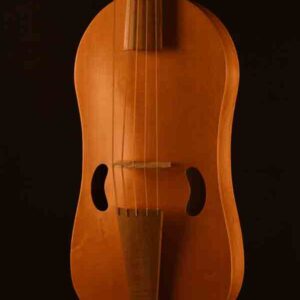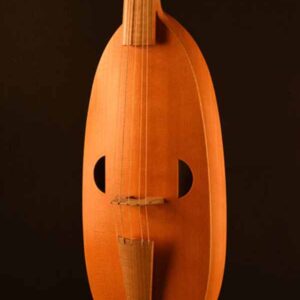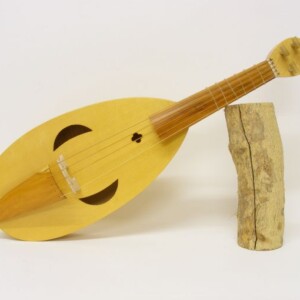Vielles (medieval fiddles)
In making musical instruments from a period where virtually no complete examples survive, the maker is left to make his instruments from iconography of the period in the form of illuminations from manuscripts, carvings in churches and art. These images usually only show the front of instruments, and can often be out of proportion and unclear in detail, leaving the maker many unanswered questions of size, construction, materials etc. Another source of inspiration, is writings from the period, not only about musical instruments and musicians, but also sermons and writings on related subjects such as religion, carpentry, science and art.
Click on the images below for more pictures and details and read below for more of my thoughts on making medieval vielles.


Just like all of my instruments, my vielles are individually made with the finest materials and attention to every detail, and despite a popular belief to the contrary, I don’t believe that medieval instruments were ever made to any other standard. Although we have no surviving instruments as an example, one only has to look to contemporary art, crafts, architecture, cathedrals, houses, writing, music etc to see that medieval craftsmen and artists were no less exacting than the great Cremonese violin makers of the 16th to the 18th centuries.
Varnish recipes that are identical to what is seen on these violins date back hundreds of years prior to the golden age of violin making and are therefore just as appropriate on medieval craft. The modern idea of unvarnished or simply oiled or waxed musical instruments is not supported by any evidence nor is the idea that musicians made their own instruments which were therefore of a low standard of craftsmanship. On the contrary, all crafts were carefully guarded by guilds and required specific training in order to be carried out at a professional level.
Although the production of sound from bowed stringed instruments certainly peaked with the work of Amati, Stradivari and Guarneri, there is no reason to believe that a medieval musician would settle for mediocre sound quality from an instrument that he had commissioned. The medieval fiddle was around for at least 600 years before violins were ever conceived and it is impossible to imagine that their construction and playability did not evolve to a very high level during that time. To imagine that they were just basic versions of violins that sounded rough or harsh because their makers didn’t really know what they were doing is an offence to their memory. What craftsman, who over the course of his working life could have produced hundreds of vielles, would not a have strived in each and every subsequent instrument, to improve upon and develop his ability to produce the best finish, sound and projection that he could? And just because we have little evidence, who is to say that there were not also families of makers, who over the course of generations, built their tradition and, in turn actually made the advent of the violin even a possibility. Amati is credited as being the genius who ‘invented’ the violin, but what if this is just a romantic notion that ignores the countless generations of unrecorded makers from whom he inherited his intuition?
All of this knowledge is lost. It has been lost since the end of the golden age of violin making and even the intuition required to make violins in the way they used to be made is perhaps still to be rediscovered. All because an aural and intuitive tradition came to an end without ever being recorded.
Therefore, it has to be re learned and it is no less different for medieval fiddles. We must strive, without excuse, to make the very best sounding instruments and not settle for anything other than the very best craftsmanship, research and dedication that the medieval craftsmen utilised.
“Then he commanded a fine fiddle with silk strings to be prepared for him as if it were for a prince to use; the body decorated,the neck inlaid with gold, precious stones and noble ivory. Below the neck there hung a band of soft silk; the fiddle was all adorned with golden braid of silk. Thus the gige was made. The pegs were golden, and the fiddle-bag seemed to be of fine silk embroidered with beautiful pictures.”
Anon, early 14th century
There are differing theories as to what, if anything, there is on the inside of vielles in terms of structural support. They clearly must be different to violins with their bass-bar and soundpost – a method that probably wasn’t fully employed until the 16th century. There can be no hard and fast rules that apply to all types of vielle – we are, after all, dealing with a period of around 400 years across a very large geographical area. I have built instruments with and without internal support, with falt or carved fronts, carved or bent ribs and flat and curved bridges – all of which are successful in their own ways.
As a maker, my greatest priority is to build instruments that work for the modern player and I am very happy to adapt or modify designs, setup, stringing, etc, to suit. A specific concern is their playability with great attention to the fingerboard, neck, nut and pegs.

